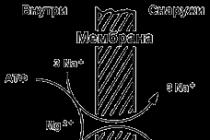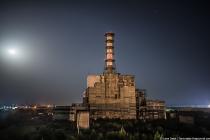Few people in our country and in the world will be able to challenge the significance of the victory at Stalingrad. The events that took place between July 17, 1942 and February 2, 1943 gave hope to the peoples who were still under occupation. Next, 10 facts from the history of the Battle of Stalingrad will be given, designed to reflect the severity of the conditions in which the hostilities were fought, and, perhaps, to tell something new that makes you take a different look at this event from the history of World War II.
1. To say that the battle for Stalingrad took place in difficult conditions is like saying nothing. The Soviet troops in this area were in dire need of anti-tank guns and anti-aircraft artillery, and there was also not enough ammunition - some formations simply did not have them. The soldiers got what they needed as best they could, mostly taking it from their dead comrades. There were enough dead Soviet soldiers, since most of the divisions thrown to hold the city, named after the main man in the USSR, consisted either of unfired newcomers who arrived from the Stavka reserve, or of soldiers exhausted in previous battles. This situation was aggravated by the open steppe terrain in which the fighting took place. This factor allowed the enemies to regularly inflict heavy damage on Soviet troops in equipment and people. Young officers, who just yesterday left the walls of military schools, went into battle like ordinary soldiers and died one after another.
2. At the mention of the Battle of Stalingrad, images of street fighting, which are so often shown in documentaries and feature films, pop up in the minds of many. However, few people remember that although the Germans approached the city on August 23, they began the assault only on September 14, and far from the best Paulus divisions participated in the assault. If we develop this idea further, we can come to the conclusion that if the defense of Stalingrad had been concentrated only in the city, it would have fallen, and fallen quite quickly. So what saved the city and held back the enemy onslaught? The answer is continuous counterattacks. Only after repulsing the counterattack of the 1st Guards Army on September 3, the Germans were able to begin preparations for the assault. All offensives by Soviet troops were carried out from the northern direction and did not stop even after the start of the assault. So, on September 18, the Red Army, having received reinforcements, was able to launch another counterattack, because of which the enemy even had to transfer part of the forces from Stalingrad. The next blow was inflicted by the Soviet troops on September 24th. Such countermeasures did not allow the Wehrmacht to concentrate all its forces to attack the city and constantly kept the soldiers on their toes.
If you are wondering why this is so rarely mentioned, then everything is simple. The main task of all these counter-offensives was to reach the connection with the defenders of the city, and it was not possible to fulfill it, while colossal losses were incurred. This can be clearly seen in the fate of the 241st and 167th tank brigades. They had 48 and 50 tanks, respectively, on which they pinned their hopes as the main striking force in the counteroffensive of the 24th Army. On the morning of September 30, during the offensive, the Soviet forces were covered by enemy fire, as a result of which the infantry fell behind the tanks, and both tank brigades hid behind a hill, and a few hours later, radio communications with the vehicles that broke deep into the enemy defenses were lost. By the end of the day, out of 98 vehicles, only four remained in service. Later, two more damaged tanks from these brigades were able to be evacuated from the battlefield. The reasons for this failure, like all the previous ones, were the well-built defense of the Germans and the poor training of the Soviet troops, for whom Stalingrad became a place of baptism of fire. The chief of staff of the Don Front, Major General Malinin himself, said that if he had at least one well-trained infantry regiment, he would march all the way to Stalingrad, and that it’s not the enemy’s artillery that does its job well and presses the soldiers to the ground, but in the fact that at this time they do not rise to the attack. It is for these reasons that most writers and historians of the post-war period were silent about such counterattacks. They did not want to darken the picture of the triumph of the Soviet people, or they were simply afraid that such facts would become an occasion for excessive attention to their person by the regime.
3. The soldiers of the Axis who survived the Battle of Stalingrad, later usually noted that it was a real bloody absurdity. They, being by that time already hardened soldiers in many battles, in Stalingrad felt like rookies who did not know what to do. The Wehrmacht command seems to have been subjected to the same sentiments, since during urban battles it sometimes gave orders to storm very insignificant areas, where sometimes up to several thousand soldiers died. Also, the fate of the Nazis locked in the Stalingrad cauldron was not facilitated by the air supply of troops organized by order of Hitler, since such aircraft were often shot down by Soviet forces, and the cargo that nevertheless reached the addressee sometimes did not satisfy the needs of the soldiers at all. So, for example, the Germans, who were in dire need of provisions and ammunition, received a parcel from the sky, consisting entirely of women's mink coats.
Tired and exhausted, the soldiers at that time could only rely on God, especially since the Octave of Christmas was approaching - one of the main Catholic holidays, which is celebrated from December 25 to January 1. There is a version that it was precisely because of the upcoming holiday that Paulus' army did not leave the encirclement of Soviet troops. Based on the analysis of the letters of the Germans and their allies home, they prepared provisions and gifts for friends and waited for these days as a miracle. There is even evidence that the German command turned to the Soviet generals with a request for a ceasefire on Christmas night. However, the USSR had its own plans, so on Christmas the artillery worked at full strength and made the night of December 24-25 the last in their lives for many German soldiers.
4. On August 30, 1942, a Messerschmitt was shot down over Sarepta. Its pilot, Count Heinrich von Einsiedel, managed to land the plane with the landing gear retracted and was taken prisoner. He was a famous Luftwaffe ace from the squadron JG 3 "Udet" and "concurrently" the great-grandson of the "Iron Chancellor" Otto von Bismarck. Such news, of course, immediately hit the propaganda leaflets, designed to raise the spirit of the Soviet fighters. Einsiedel himself was sent to an officer camp near Moscow, where he soon met with Paulus. Since Heinrich was never an ardent supporter of Hitler's theory of a superior race and purity of blood, he went to war with the belief that the Great Reich was waging war on the Eastern Front not with the Russian nation, but with Bolshevism. However, the captivity forced him to reconsider his views, and in 1944 he became a member of the anti-fascist committee "Free Germany", and then a member of the editorial board of the newspaper of the same name. Bismarck was not the only historical image that the Soviet propaganda machine exploited to boost the morale of the soldiers. So, for example, propagandists started a rumor that in the 51st Army there was a detachment of submachine gunners commanded by Senior Lieutenant Alexander Nevsky - not just the full namesake of the prince who defeated the Germans under Lake Peipsi, but also his direct descendant. He was allegedly presented to the Order of the Red Banner, but such a person does not appear on the lists of holders of the order.
5. During the Battle of Stalingrad, Soviet commanders successfully used psychological pressure on the sore points of enemy soldiers. So, in rare moments, when hostilities subsided in certain areas, propagandists through speakers installed near enemy positions transmitted songs native to the Germans, which were interrupted by reports of breakthroughs by Soviet troops in one or another sector of the front. But the most cruel and therefore the most effective was considered a method called "Timer and Tango" or "Timer Tango". During this attack on the psyche, the Soviet troops transmitted through the loudspeakers the steady beat of a metronome, which, after the seventh stroke, was interrupted by a message in German: "Every seven seconds, one German soldier dies at the front." Then the metronome again counted seven seconds, and the message was repeated. This could go on 10 – 20 times, and then a tango melody sounded over the enemy positions. Therefore, it is not surprising that many of those who were locked in the “boiler”, after several such impacts, fell into hysterics and tried to escape, dooming themselves, and sometimes their colleagues, to certain death.
6. After the completion of the Soviet operation "Ring", 130 thousand enemy soldiers were captured by the Red Army, but only about 5000 returned home after the war. Most of them died in the first year of their captivity from illness and hypothermia, which the prisoners had developed even before they were captured. But there was another reason: of the total number of prisoners, only 110 thousand turned out to be Germans, all the rest were from among the Khiva. They voluntarily went over to the side of the enemy and, according to the calculations of the Wehrmacht, had to faithfully serve Germany in its liberation struggle against Bolshevism. So, for example, one sixth of the total number of soldiers of the 6th army of Paulus (about 52 thousand people) consisted of such volunteers.
After being captured by the Red Army, such people were already considered not as prisoners of war, but as traitors to the motherland, which, according to the law of wartime, is punishable by death. However, there were cases when captured Germans became a kind of "Khivi" for the Red Army. A vivid example of this is the case that occurred in the platoon of Lieutenant Druz. Several of his fighters, who were sent in search of the "language", returned to the trenches with an exhausted and mortally frightened German. It soon became clear that he did not have any valuable information about the actions of the enemy, so he should have been sent to the rear, but due to heavy shelling, this promised losses. Most often, such prisoners were simply disposed of, but luck smiled at this. The fact is that the prisoner before the war worked as a teacher of the German language, therefore, on the personal order of the battalion commander, they saved his life and even put him on allowance, in exchange for the fact that the Fritz would teach German intelligence officers from the battalion. True, according to Nikolai Viktorovich Druz himself, a month later the German was blown up by a German mine, but during this time he more or less taught the soldiers the language of the enemy at an accelerated pace.
7. On February 2, 1943, the last German soldiers laid down their arms in Stalingrad. Field Marshal Paulus himself surrendered even earlier, on January 31. Officially, the place of surrender of the commander of the 6th Army is his headquarters in the basement of a building that was once a department store. However, some researchers do not agree with this and believe that the documents indicate a different place. According to them, the headquarters of the German field marshal was located in the building of the Stalingrad executive committee. But such a "defilement" of the building of Soviet power, apparently, did not suit the ruling regime, and the story was slightly corrected. True or not, perhaps it will never be established, but the theory itself has the right to life, because absolutely everything could happen.
8. On May 2, 1943, thanks to the joint initiative of the leadership of the NKVD and the city authorities, a football match took place at the Stalingrad Azot stadium, which became known as the “match on the ruins of Stalingrad”. The Dynamo team, which was assembled from local players, met on the field with the leading team of the USSR - Spartak Moscow. The friendly match ended with the score 1:0 in favor of Dynamo. Until today, it is not known whether the result was rigged, or whether the defenders of the city, hardened in battle, were simply used to fighting and winning. Be that as it may, the organizers of the match managed to do the most important thing - to unite the inhabitants of the city and give them hope that all the attributes of peaceful life are returning to Stalingrad.
9. On November 29, 1943, Winston Churchill, at a ceremony in honor of the opening of the Tehran Conference, solemnly presented Joseph Stalin with a sword forged by special decree of King George VI of Great Britain. This blade was given as a token of British admiration for the courage shown by the defenders of Stalingrad. Along the entire blade was an inscription in Russian and English: “To the inhabitants of Stalingrad, whose hearts are strong as steel. A gift from King George VI as a token of the great admiration of the entire British people."
The decoration of the sword was made of gold, silver, leather and crystal. It is rightfully considered a masterpiece of modern blacksmithing. Today, any visitor to the Museum of the Battle of Stalingrad in Volgograd can see it. In addition to the original, three copies were also released. One is in the Museum of Swords in London, the second is in the National Museum of Military History in South Africa, and the third is part of the collection of the head of the diplomatic mission of the United States of America in London.
10. An interesting fact is that after the end of the battle, Stalingrad could completely cease to exist. The fact is that in February 1943, almost immediately after the surrender of the Germans, the Soviet government faced an acute question: is it worth restoring the city, after all, after fierce fighting, Stalingrad lay in ruins? It was cheaper to build a new city. Nevertheless, Joseph Stalin insisted on restoration, and the city was resurrected from the ashes. However, the residents themselves say that after that, for a long time, some streets exuded a putrid smell, and Mamaev Kurgan, due to the large number of bombs dropped on it, did not grow grass for more than two years.

Tortured soldier of the Red Army, February 1943, Stalingrad

Victims of the Alekseevsky prisoner of war camp "Dulag-205"

The bodies of those killed in the concentration camp "Gospitomnik" Gorodishchensky district

Concentration camp "Hospital"

Memorandum of V. Abakumov to A. Vyshinsky about the brutal attitude of German military personnel towards Soviet prisoners of war
To the Council of People's Commissars of the USSR Comrade Vyshinsky
In mid-January 1943, squeezing the encirclement around the 6th German Army, our troops captured the transit camp for prisoners of war, the so-called Dulag-205, located near the village of Alekseevka near Stalingrad. On the territory of the camp and near it, thousands of corpses of Red Army prisoners of war and commanders who died of exhaustion and cold were found, and several hundred tormented, emaciated from hunger and extremely exhausted were released. soldiers of the Red Army.
In this regard, the Smersh Main Directorate conducted an investigation, during which it was revealed that German officers and soldiers, following the instructions of the German military command, treated prisoners of war mockingly, brutally exterminated them through mass beatings and executions, created unbearable conditions in the camp and starved. It was also established that a similar brutal attitude of the Germans towards prisoners of war also took place in the prisoner of war camps in Darnitsa near Kyiv, Dergachi near Kharkov, in Poltava and Rossosh.
The direct culprits of the death of Soviet people were currently under investigation in the Main Directorate "Smersh":
Rudolf Kerpert, former commandant of the Dulag-205 camp, colonel in the German army, born in 1886, a native of the Sudetenland (Germany), from a merchant family. He was taken prisoner on January 31, 1943 in Stalingrad.
Von Kunowski Werner, former chief quartermaster of the 6th German army, lieutenant colonel of the German army, born in 1907, native of Silesia, nobleman, son of a major general of the German army. He was taken prisoner on January 31, 1943 in Stalingrad.
Langheld Wilhelm - a former counterintelligence officer (Abwehr officer) at the Dulag-205 camp, captain of the German army, born in 1891, a native of the mountains. Frankfurt am Main, from the family of an official, member of the National Socialist Party since 1933. He was taken prisoner on January 31, 1943 in Stalingrad.
Meder Otto, former adjutant of the commandant of the Dulag-205 camp, chief lieutenant of the German army, born in 1895, a native of the Erfurt district (Germany), a member of the fascist party since 1935. He was taken prisoner on January 31, 1943 near Stalingrad.
The testimony of Kunovskiy, Langheld and Meder established that there was a direct order from the high command of the German army to exterminate Soviet prisoners of war - officers and privates, as "inferior" people.
So, the former counterintelligence officer at the camp, Captain Langheld, during interrogation on September 1, 1943, testified:
“The German command considered Russian prisoners of war as working cattle needed to perform various jobs. The Russian prisoners of war held in the Alekseevsky camp "Dulag-205", as well as in other German prisoner of war camps, were fed starving only so that they could work for us.
The atrocities that we perpetrated on prisoners of war were aimed at exterminating them as superfluous people. In addition, I must say that in our behavior with Russian prisoners of war, we proceeded from the special attitude towards all Russian people that existed in the German army.
In the German army, in relation to the Russians, there was a conviction that is law for us: “The Russians are an inferior people, barbarians who have no culture. The Germans are called upon to establish a new order in Russia.” This conviction was instilled in us by the German government. We also knew that there were many Russian people and it was necessary to destroy as many of them as possible in order to prevent the possibility of any resistance to the Germans after the establishment of a new order in Russia.
Bullying of Russian prisoners of war was carried out by both soldiers and officers of the German army who had anything to do with prisoners of war.
This explains that in the Alekseevsky camp, designed for 1,200 people, up to 4,000 Soviet prisoners of war were imprisoned, placed in incredible crowding and in terrible unsanitary conditions.
As the German officers Kerpert, Kunovskiy, Langheld and Meder showed, the Soviet prisoners of war, while in Dulag-205, were fed from hand to mouth, and from the beginning of December 1942, the command of the 6th German Army, represented by the chief of staff, Lieutenant General Schmidt, completely stopped supplying the camp food, as a result of which mass mortality arose among prisoners of war due to starvation. From December 5, 1942, the death rate among prisoners of war from starvation reached 50-60 people a day, and by the time the camp was liberated by the Red Army, about 3,000 people had died.
The former Chief Quartermaster of the 6th German Army, Lieutenant Colonel Kunovsky, during interrogation on August 25-26, 1943, testified:
“... Personally, just like the chief of staff of the 6th German army, Lieutenant General Schmidt, like other German officers, I treated Soviet prisoners of war as inferior people.
When prisoners of war, being exhausted by hunger, lost their value for us as a labor force, in my opinion, nothing prevented us from shooting them. True, the prisoners of war were not shot, but they were starved to death. The goal has been reached. Over 3,000 people who could be set free in connection with the defeat of the 6th German army - we exterminated.
I think that even those few prisoners of war who remained alive will never be able to restore their health and will remain crippled for life.
“... The prisoners of war were placed in incredible crowding. They were completely deprived of the opportunity to lie down and slept sitting ...
On December 5, 1942, a real famine began among the prisoners of war, on the basis of which a high mortality occurred among them. Since December 10, about 50 people have died every day. The corpses of prisoners of war who died overnight were thrown out of the dugouts every morning, taken outside the camp and buried.
Alekseevka, Dulag-205
This is also confirmed by Lieutenant Meder, who also stated that he repeatedly reported on the situation in the camp to the Chief Quartermaster of the 6th German Army Kunovsky, who, however, did not take any measures to supply the camp with food and once told Meder that the prisoners needed to be shot. Meder, during interrogation on August 27, 1943, testified:
“... Colonel Kerpert never went to the army headquarters in order to personally demand food for prisoners of war, but only wrote memos about hunger and mortality in the camp. He sent these notes through me and other camp staff to Kunovsky's headquarters.
On December 5 or 6, 1942, during one of my reports to Kunovskiy, I asked him if I should talk about the situation in the camp with the chief of staff of the army. To this, Kunovskiy replied that the chief of staff was absent and that in general a direct appeal was unnecessary, since he himself reported to the command. To my categorical question: “What will you order us to do in two days, when the prisoners of war will not have a single gram of food?” Kunovsky shrugged his shoulders and said: “Then we will have to shoot the prisoners of war.” Then there were about 4,000 prisoners of war in the camp.”
Continuing his testimony, Kunovsky stated on this issue that he informed the Chief of Staff of the 6th German Army, Lieutenant General Schmidt, about the situation in the camp, but at the same time they did not take any measures to alleviate the plight of the prisoners of war. In addition, Kerpert, Langheld and Meder testified that German officers and soldiers beat Soviet prisoners of war for minor offenses, for sluggishness in work, and also without any faults.
Prisoners of war, driven mad by hunger, during the distribution of food prepared from various carrion, were poisoned by dogs to establish "order". Lyangheld said that, while interrogating prisoners of war, he himself, his sergeant major and translator, in order to obtain military intelligence from them, beat Russian prisoners of war. The camp guards - soldiers and officers - also systematically beat the prisoners of war.
Langheld confessed that he provoked, through his agents, attempts to escape the prisoners of war, as a result of which they were shot. This practice of violence, bullying, murder and provocation was widely used not only in the Alekseevsky camp, but also, as Kunovskiy, Langheld and Meder know, in other prisoner-of-war camps.
Langheld showed:
“Usually, I beat prisoners of war with sticks 4-5 cm in diameter, but this was not only in Alekseevka. I worked in other POW camps: in Darnitsa near Kyiv, Dergachi near Kharkov, in Poltava and in Rossosh. In all these camps, the beating of prisoners of war was practiced. The beating of prisoners of war was common in the German army.
In the Poltava camp, German soldiers from the guards fired small-caliber rifles at prisoners of war because they urinated in a place where it was not supposed to.
Wounded Soviet soldiers in a German camp, 1942 (Photo found on a German officer taken prisoner near Stalingrad.)
About the brutal treatment of prisoners of war by the German authorities, Kunovskiy testified:
“In the spring of 1942, typhus raged in Kharkov, in the POW camps. Quarantine measures were not enforced and high mortality occurred in these camps. The doctors told me about it.
Soviet prisoners of war worked on the restoration of the Chir railway station. According to the commander of the battalion, who supervised these works, among the prisoners of war, as a result of exhaustion, diseases and high mortality arose.
The German military authorities also treated the civilian population of the occupied regions inhumanly and criminally. So, for example, in June 1942, mobilized workers were sent from Kharkov to work in Germany. The transport of these workers was carried out in appalling conditions. The food was exceptionally poor, and there was not even straw in the wagons so that the workers could lie down during the long journey.”
The adjutant of the commandant of the Dulag-205 camp Meder, being interrogated, testified:
“...Before mobilization into the army, I lived in the city of Burg, where Russian prisoners of war were brought for agricultural work. These prisoners of war were extremely emaciated and exhausted. Judging by the fact that the Russian soldiers whom I later had to see looked well-fed and healthy, I believe that the prisoners of war who came to us in Burg, in the camps and during transportation, ate extremely poorly.
In Alekseevka, in Dulag-205, where I served, there were several angry dogs. Dogs were used to restore order among prisoners of war. During the distribution of food (when the kitchens were still working), prisoners of war lined up to get some stew. Sometimes hungry people (some of them went crazy from hunger) broke the line, then the dog breeders set the dogs on them.
In the course of the investigation into the case of Kerpert, Kunovskiy, Lyanghheld and Meder, former servicemen of the Red Army - K.S. Krupachenko, K.K. Pisanovskiy, I.D. Kasinov, S.M. and Alekseev A.A., who for a long period of time, being held captive by the Germans, were kept in Dulag-205. These persons testified about the mass mortality among prisoners of war from starvation and the brutal treatment of Russian prisoners of war by the German command.
Yes, former soldier of the Red Army Alekseev A.A. during interrogation on August 10, 1943, he testified:
“... There was a high mortality in the camp, the reason for this was the following: during the entire time of my stay in the camp, prisoners of war were not given bread or water at all ...
Instead of water, dirty bloodied snow was raked out in the camp area, after which there were massive diseases of prisoners of war. There was no medical assistance. I personally had 4 wounds, and despite my repeated requests, no help was provided, the wounds festered. The German sentries fired at the POWs without warning. I personally saw how one prisoner of war, I don’t know his last name, during the distribution of food, tried to cut off a piece of horse skin with a knife - he was noticed by a sentry who shot at point-blank range at a prisoner of war and shot him. There were many such cases.
We slept on the ground in the mud, there was absolutely no place to warm ourselves from the cold. Felt boots and warm clothes were taken away from the prisoners of war, in return they were given torn shoes and clothes taken from the dead and the dead ...
Many of the prisoners of war, unable to endure the horrors of the camp situation, went crazy. 150 people died a day, and in the first days of January 1943, 216 people died in one day, as I learned from the workers of the camp's medical unit. The German command of the camp poisoned prisoners of war with dogs - shepherd dogs. The dogs knocked down the weakened prisoners of war and dragged them through the snow, while the Germans stood and laughed at them. Public executions of prisoners of war were practiced in the camp ... "
"... In the prisoner of war camp for the slightest violations: noise in the queue when receiving food, failure, being late for duty - the prisoners were systematically beaten with sticks, indiscriminately guilty."
Similar testimony, illustrated by the facts of German atrocities against prisoners of war, was given by other former. soldiers of the Red Army.
Kerpert, Kunovsky, Langheld and Meder pleaded guilty to the crimes they had committed.
The investigation into the case is ongoing. I have put a question to the Government about the expediency of organizing a public trial in the case, with its coverage in the press.
Abakumov
CA FSB RF, f. 14, op. 5, d. 1, l. 228-235 (original)
Mortality among prisoners on the eastern front in the camps of the USSR was less than 15%, in the war with Japan - less than 10% (in contrast to almost 60% in the Nazi camps). The answer to the question why half of the Nazis died before 44 is given below ...Grigory Pernavsky
Why did Stalingrad prisoners die?
From time to time on the Internet and in the periodical press, in articles dedicated to the next anniversary of the defeat of the Germans at Stalingrad, there are references to the sad fate of German prisoners of war. Often their fate is compared with the fate of millions of Red Army soldiers who were tortured to death in German camps. Thus, unscrupulous propagandists are trying to demonstrate the identity of the Soviet and Nazi regimes. About attitude
M-yes. (February 1943, quite a lot of Germans have been written to Soviet prisoners of war. As for the Soviet side, the USSR, which at one time did not sign the Geneva Convention of 1929 "On the Maintenance of Prisoners of War" (the reasons for not signing it are known, but are not the subject of this article), announced that it would comply with it, in the very first days after the start of World War II.
At the initial stage of the war, there were no difficulties with keeping prisoners of war for the simple reason that there were too few of them. From June 22 to December 31, 1941, 9,147 people were taken prisoner by the Red Army, and by November 19, 1942, when the counteroffensive near Stalingrad began, another 10,635 enemy soldiers and officers entered the rear camps for prisoners of war ...
The leaflets addressed to the German and Finnish soldiers guaranteed their life and good treatment. However, Soviet propaganda did not have any noticeable effect on the enemy. One of the reasons for this failure was the repeated cases of the killing of captured Germans by the Red Army. There were relatively few such cases, but the facts of the inhumane attitude of Soviet soldiers towards German prisoners were immediately widely "PR" by Nazi propaganda. Subsequently, it was the fear of death at the hands of a "ruthless enemy" that caused the death of many Wehrmacht soldiers, who preferred death from starvation and typhus to Soviet captivity.
The first major encirclement that the Red Army managed to complete was the encirclement of the German 6th Army near Stalingrad. On November 19, 1942, the Soviet counteroffensive began. ..
It is worth noting that the problems with the supply of the Paulus group began long before the start of the Soviet operation "Uranus". In September 1942, the actual food ration that the soldiers of the 6th Army received was about 1800 calories per day, if necessary, taking into account loads, 3000-4000. In October 1942, the command of the 6th Army reported to the OKH that since August "living conditions throughout the entire range of the 6th Army are equally bad." The organization of additional food supplies through the requisition of local sources was no longer possible (in other words, everything that the soldiers of the valiant Wehrmacht stole from the civilian population was eaten). For this reason, the command of the 6th Army asked to increase the daily ration of bread from 600 to 750 grams. Supply difficulties were superimposed by the ever-increasing physical and mental exhaustion of soldiers and officers. By the time the Soviet counteroffensive began, they seemed terrifying, but the real horror began after 19 November. Continuous battles with the advancing Red Army, the slow retreat to Stalingrad, the fear of death, which seemed more and more inevitable, constant hypothermia and malnutrition, which gradually turned into hunger, quickly undermined morale and discipline.
Malnutrition was the biggest problem. From November 26, the food ration in the "cauldron" was reduced to 350 gr. bread and 120 gr. meat. On December 1, the norm for issuing bread had to be reduced to 300 grams. On December 8, the norm for issuing bread was reduced to 200 gr. It is worth recalling that the minimum norm of bread given to workers in besieged Leningrad in November-December 1941 was 250 gr. However, for some time the Germans received horsemeat welds for their skinny rations.
A hungry person quickly loses the ability to think, falls into apathy and becomes indifferent to everything. The defense capability of the German troops was rapidly declining. On December 12 and 14, the command of the 79th Infantry Division reported to the headquarters of the 6th Army that, due to prolonged fighting and insufficient food supplies, it was no longer able to hold its positions.
By Christmas, for a few days, the soldiers of the front line were given an additional 100 gr. It is known that at the same time, some soldiers in the "cauldron" received no more than 100 gr. of bread. (For comparison: the same amount - the minimum that the children and dependents of Oranienbaum received in besieged Leningrad). Even if this is not so, such a “diet”, for quite a long time for thousands of adult men who experienced extreme physical and mental stress, meant only one thing - death. And she did not keep herself waiting. From November 26 to December 22, 56 deaths were recorded in the 6th Army, "in which lack of nutrition played a significant role."
By December 24, there were already 64 such cases. On December 20, a report was received from the IV Army Corps that "due to loss of strength, two soldiers died." It is worth noting that hunger kills adult men even before they have complete dystrophy. They generally endure hunger worse than women. On January 7, recorded deaths from starvation were already 120 people a day.
Paulus and his subordinates were well aware of the catastrophic situation their troops were in. On December 26, the head of the rear of the encircled group, Major von Kunowski, in a telegraph conversation with Colonel Fink, head of the rear of the 6th Army, who was outside the ring, wrote:
"I ask you by all means to ensure that 200 tons are delivered to us by plane tomorrow ... I have never sat so deep in shit in my life."
However, no amount of pleading could fix the continuously deteriorating situation. In the period from January 1 to January 7 in the LI building, a daily ration of 281 grams per person was issued. gross, with a norm of 800. But in this building the situation was relatively good. On average, the distribution of bread in the 6th Army was reduced to 50-100 grams. Soldiers on the front line received 200 each. It is amazing, but with such a catastrophic shortage of food, some warehouses inside the "cauldron" were literally bursting with food and fell into the hands of the Red Army in this form. This tragic curiosity is due to the fact that by the end of December, due to an acute shortage of fuel, freight transport completely stopped, and riding horses died or were slaughtered for meat. The supply system inside the “cauldron” turned out to be completely disorganized and often the soldiers died of starvation, not knowing that saving food was literally a few kilometers from them. However, there were fewer and fewer people left in the 6th Army who could overcome even such a short distance on foot. On the 20th of January, the commander of one of the companies, which was to make a one and a half kilometer march, despite the fact that there was no shelling from the Soviet side, told his soldiers: "Whoever lags behind will have to be left lying in the snow, and he will freeze." On January 23, the same company for a four-kilometer march took time from 6 in the morning until dark.
Since January 24, the supply system in the "cauldron" has completely collapsed. According to eyewitnesses, nutrition improved in some areas of the encirclement, since there was no longer any accounting for the distribution of food. Containers dropped from aircraft were stolen, and it was simply not possible to organize the delivery of the rest. The command took the most draconian measures against the marauders. In the last weeks of the existence of the "cauldron", dozens of soldiers and non-commissioned officers were shot by the field gendarmerie, but most of the encirclement, distraught with hunger, did not care. On the same days, in other areas of the "cauldron" soldiers received 38 gr. bread, and a can of Cola chocolate (several round bars of tonic chocolate, the size of a palm) was divided into 23 people.
“In connection with the successful operations of the Red Army units on the Southwestern, Stalingrad and Don fronts, the dispatch of prisoners of war is taking place with great difficulty, resulting in a high mortality rate among prisoners of war.
As established, the main causes of death are:
1. Romanian and Italian prisoners of war from 6-7 to 10 days before being taken prisoner did not receive food due to the fact that all food supplied to the front went primarily to German units.
2. When captured, our units of prisoners of war are driven on foot 200-300 km to the railway, while their supply with the rear units of the Red Army is not organized and often for 2-3 days on the way the prisoners of war are not fed at all.
3. The points of concentration of prisoners of war, as well as the reception points of the NKVD, should be provided by the Headquarters of the Logistics of the Red Army with food and uniforms for the route. In practice, this is not done, and in a number of cases, when loading echelons, prisoners of war are given flour instead of bread, and there are no dishes.
4. The military communications authorities of the Red Army supply wagons for sending prisoners of war, not equipped with bunks and stoves, and 50-60 people are loaded into each wagon.
In addition, a significant part of the prisoners of war do not have warm clothes, and the trophy property of the rear services of the fronts and armies is not allocated for these purposes, despite the instructions of Comrade. Khruleva on these issues...
And, finally, contrary to the Regulations on prisoners of war, approved by the Council of People's Commissars of the USSR, and the order of the Glavvoensanupr of the Red Army, wounded and sick prisoners of war are not accepted into front-line hospitals and are sent to reception centers "
This memorandum gave rise to a rather harsh reaction at the very top of the Red Army command. Already on January 2, 1943, the order of the People's Commissar of Defense No. 001 was issued. It was signed by the Deputy People's Commissar, Head of the Quartermaster Service of the Red Army, Colonel-General of the Quartermaster Service A.V. Khrulev, but there is no doubt that this paper did not escape the attention of the Supreme Commander himself:
(Some of the documents have been shortened, as well as a number of other documents have been deleted. The article does not fit into the message completely.) their texts are given in full in the book.
Looking ahead, it makes sense to clarify that during the whole of 1943 it was not possible to establish a normal evacuation of prisoners of war from the front. It must be assumed that such an important order was issued too late, and it would be foolish to expect that it could be properly carried out in less than a month, when the Red Army was hit by a stream of emaciated and sick prisoners of war.
Paulus rejected the ultimatum of the Soviet command (according to the memoirs of Rokossovsky, Soviet parliamentarians were fired upon from the German side) and on January 10, 1943, hell broke out on the outskirts of Stalingrad ... Here is what the commander of the 767th Grenadier Regiment of the 376th Infantry Division, Colonel Luitpold Shteidle, recalled about subsequent events:
“On January 10, at 8:50 a.m., the Russians begin an artillery shelling even stronger than on November 19: “Stalin's organs” howl for 55 minutes, heavy guns rumble - volley after volley without interruption. Hurricane fire plows the whole earth. The last assault on the boiler began.
Then the thunder of guns stops, white-painted tanks approach, followed by submachine gunners in camouflage coats. We leave Marinovka, then Dmitrievka. All living things drape into the Rossoshka valley. We dig ourselves in at Dubinin, and two days later we find ourselves in the area of the Pitomnik station in Tolovaya, a beam. The cauldron gradually shrinks from west to east: on the 15th to Rossoshka, on the 18th to the line Voroponovo - Nursery - Gonchar's farm, on the 22nd to Verkhne-Elshashsh - Gumrak. Then we hand over Gumrak. The last opportunity to take out the wounded and receive ammunition and food is disappearing.
(...) On January 16, our division ceases to exist (..).
(…)Decomposition intensifies. Other officers, such as, for example, the head of the operations department of the headquarters of our division, Major Vilutsky, flee by plane. After the loss of the Kennel, the planes land at Gumrak, which the Russians bombard continuously. Other officers, after the disbandment of their units, secretly flee to Stalingrad. More and more officers want to fight their way to the receding German front alone. There are such people in my battle group (...)”
Soon Steidle himself joined this dreary stream. At that time, street fighting was still going on in Stalingrad, the city was literally packed with soldiers and officers who did not know what to do now. Someone cherished the hope of getting out of the boiler on their own, someone wanted to understand what was happening and receive clear orders, and someone simply hoped to find food and shelter in the city. Neither one nor the other, nor the third, achieved their goals. Stalingrad in the second half of January turned into an island of despair shelled from all sides:
“An uncountable number of soldiers are moving along the street in front of the barred windows. For many days they have been moving from one trench to another, rummaging through abandoned vehicles. Many of them came from fortified cellars on the outskirts of Stalingrad; they were knocked out by Soviet assault groups; here they are looking for somewhere to hide. Here and there an officer appears. In this turmoil, he is trying to collect combat-ready soldiers. However, many of them choose to join some unit as stragglers. Soviet troops are advancing and advancing non-stop from one quarter, garden, factory area to another, seizing position after position. (…) Many are extremely tired to end this on their own and leave this crumbling front. These continue to fight, as others stand next to them, intending to defend their lives to the last bullet, those who still see the real enemy in the Soviet soldier or are afraid of retribution.
Around us are the ruins and smoking ruins of a huge city, and behind them flows the Volga. We are being shelled from all sides. Where the tank appears, the Soviet infantry is also visible there, following directly behind the T-34. You can clearly hear the shots and the terrible music of the “Stalinist organs”, which, at short intervals, fire barrages. It has long been known that there is no defense against them. The apathy is so great that it no longer causes anxiety. It is more important to get something edible out of the pockets or bread bags of the dead and wounded. If anyone finds canned meat, he slowly eats it, and cleans the box with swollen fingers, as if it were on these last remnants that he would survive or not. And here is another terrible sight: three or four soldiers, crouched, sit around a dead horse, tear off pieces of meat and eat it raw.
Such is the position "at the front", at the forefront. The generals know it as well as we do. They are "reported" about all this, and they are considering new defensive measures.
Finally, from 30 to 2 February, the remnants of the German troops defending in the pocket laid down their arms. To the surprise of the Soviet military (who estimated the encircled group at about 86 thousand people), only 91,545 Germans (including 24 generals and about 2,500 officers) were captured from January 10 to February 22, 1943, and there were also tens of thousands of dead. The condition of the prisoners was terrible. More than 500 people were unconscious, 70 percent had dystrophy, almost all suffered from beriberi and were in a state of extreme physical and mental exhaustion. Pneumonia, tuberculosis, heart and kidney diseases were widespread. Almost 60 percent of the prisoners had frostbite of the 2nd and 3rd degree with complications in the form of gangrene and general blood poisoning. Finally, about 10 percent were in such a hopeless condition that there was no way to save them. Among other things, the prisoners entered the troops unevenly, throughout January, and the order to create a large front camp was given on the 26th of this month. Although the camp, more precisely, several distribution camps, united in department No. 108, with a center in the village of Beketovka, began to function already in the first days of February, of course, it was not possible to properly equip it.
But first, the prisoners had to be taken out of Stalingrad and somehow delivered to the camps, which were located approximately at a distance from the city, not exceeding the daily passage of a military unit consisting of healthy people. Today, Beketovka has already entered the city limits of Volgograd. On a summer day, walking from the city center to this area takes about five hours. In winter, it will take more time, but for a healthy person, such a “journey” will not become too difficult. The Germans, exhausted to the limit, are another matter. Nevertheless, they needed to be urgently withdrawn from Stalingrad. The city was almost completely destroyed. There were no premises suitable for accommodating a huge number of people, the water supply system did not function. Among the prisoners, typhus and other infectious diseases continued to spread. Leaving them in Stalingrad meant dooming them to death. Long marches to the camps also did not bode well, but at least they left chances for salvation. At any moment, the city could turn into an epidemic focus, and deadly diseases could spread to the Red Army soldiers, who also gathered a huge number in Stalingrad. Already on February 3-4, able-bodied Germans, who were still waiting to be shot, lined up in columns and began to withdraw from the city.
Some modern researchers compare the withdrawal of prisoners of war from Stalingrad with the "death marches" in Southeast Asia, during which thousands of American and British prisoners of war died at the hands of the Japanese. Is there any basis for such comparisons? More likely no than yes. First, the atrocities of the Japanese are confirmed by concrete and numerous testimonies. Secondly, the Americans and the British were captured healthy or relatively healthy (as, by the way, the Red Army soldiers were captured by the Germans). In the case of Stalingrad, the convoys had to deal with people, a significant part of whom were actually dying. There is anonymous evidence that some, completely exhausted prisoners who could no longer move, were shot by guards. At the same time, military doctor Otto Rühle, in his book Healing in Yelabuga, tells that all the fallen German soldiers were put on sleds and taken to the camp. And here is how Colonel Steidle describes his way to the camp:
A group of officers, supplemented by several soldiers and non-commissioned officers, was built in a column of eight people (in eight rows). A march was coming, which demanded from us the exertion of all forces. We took each other by the arms. They tried to slow down the pace of the march. But for those who walked at the end of the column, he was still too fast. Calls and requests to go slower did not stop, and this was all the more understandable since we took with us many with sore legs, and they could hardly move along the well-worn, icy road that shone like a mirror. What have I, as a soldier, not seen on these marches! Endless rows of houses, and in front of them - even at small huts - lovingly manicured gardens and gardens, and behind them - playing children, for whom everything that happens has either become ordinary or remains incomprehensible. And then all the time stretched endless fields, interspersed with forest belts and steep or gentle hills. In the distance, the outlines of industrial enterprises were visible. For hours we marched or rode along railroads and canals. All methods of transition were tested, up to the use of a mountain road at a dizzying height. And then again marches past the smoking ruins into which the settlements that existed for centuries were turned. (…) Snow-covered fields stretched on both sides of our path. At least, that's how it seemed to us on that January morning, when the frosty air mixed with the descending fog, and the earth seemed to be lost in infinity. Only from time to time could one see closely crowded prisoners of war, who, like us, made this march, a march of guilt and shame! (...) After about two hours, we reached a large group of buildings at the entrance to Beketovka.
At the same time, Steidle emphasizes the correct behavior of the convoy and the fact that the soldiers drove away the civilians who tried to approach the column with shots in the air.
Prisoners in Stalingrad continued to arrive until February 22, 1943. On this day, there were 91,545 enemy soldiers in the city and its environs, some of which were already, though dead. In the very first days, there were big problems with the placement of prisoners. In particular, the Beketov camp was not equipped with sufficient space. Let us turn again to Steidle's memoirs:
“We were placed there in all rooms from the basement to the attic, mostly in groups of eight, ten or fifteen people. Who at first did not grab a seat for himself had to stand or sit on the landings of the stairs as he had to. But in this building there were windows, there was a roof, water and a temporarily equipped kitchen. There were restrooms opposite the main building. In the neighboring building there was a sanitary unit with Soviet doctors and nurses. We were allowed to walk around the large courtyard at any time of the day, meet and talk with each other.
To avoid typhus, cholera, plague, and everything else that could arise from such a gathering of people, a wide campaign of protective vaccinations was organized. However, for many this event was too late. Epidemics and serious illnesses were common even in Stalingrad. Those who fell ill died alone or among comrades, wherever they could: in a crowded basement, hastily equipped as an infirmary, in some corner, in a snowy trench. No one asked why the other died. The overcoat, scarf, jacket of the dead did not disappear - the living needed it. Through them, a lot of people got infected. And here, in Beketovka, something appeared that we considered completely impossible, but which made extremely clear both the criminal nature of Hitler's actions and our own guilt for not fulfilling a long-ripened decision: a physical, mental and spiritual collapse of an unprecedented scale. Many who managed to get out of the Stalingrad hell could not stand it and died from typhus, dysentery, or complete exhaustion of physical and mental strength. Anyone who was alive a few minutes ago could suddenly collapse to the floor and be among the dead in a quarter of an hour. Any step for many could be fatal. A step into the yard, from where you will never return, a step for water, which you will never drink again, a step with a loaf of bread under your arm, which you will never eat again... Suddenly, your heart stopped beating.
Soviet women - doctors and nurses - often sacrificing themselves and not knowing peace, fought against mortality. They saved many and helped everyone. And yet it took more than one week before it was possible to stop the epidemic.
Stalingrad prisoners were sent not only to the outskirts of the destroyed city. In general, it was supposed to leave the wounded, the sick and another 20,000 people on the spot, who were supposed to be engaged in the restoration of Stalingrad. Others were to be distributed to camps located in other parts of the country. So, the surviving officers and generals were placed in Krasnogorsk near Moscow, Yelabuga, Suzdal and in the Ivanovo region. It so happened that it was those who were taken out of the Stalingrad region that made up a significant part of the survivors. Most of the prisoners met a sad fate. First, the wounded died. At the time of captivity, at least 40,000 people needed immediate hospitalization. However, camp No. 108 was not originally equipped with hospitals. They started their work only on February 15th. By February 21, 8,696 prisoners of war had already received medical care, of which 2,775 had frostbite, and 1,969 needed surgical operations due to injuries or illnesses. Despite this, people continued to die.
The general mortality among prisoners of war seriously worried the leadership of the USSR. In March, a joint commission of the People's Commissariat of Health, NGOs, the NKVD and the Executive Committee of the Union of Red Cross and Red Crescent Societies was formed, which was supposed to examine the camps of the Camp No. 108 Administration and determine the causes of such a high mortality rate. At the end of the month, the commission examined the camp in Khrenovoye. The inspection report stated:
“According to the data on the physical condition of the prisoners of war who arrived at the camp, they are characterized by the following data: a) healthy - 29 percent, b) sick and emaciated - 71 percent. The physical condition was determined by the external appearance, the group of healthy prisoners of war were those who could move independently.
Another commission, which examined the Velsk POW camp a few days later, wrote in its act:
“The prisoners of war were found to have extreme lice, their condition is very emaciated. 57 percent mortality falls on dystrophy, 33 percent. - for typhus and 10 percent. - for other diseases ... Typhus, lice, beriberi were noted in German prisoners of war while still in the encirclement in the Stalingrad region.
The general conclusions of the commission stated that many prisoners of war arrived in the camps with diseases that were irreversible. Be that as it may, by May 10, 1943, 35,099 of the first inhabitants of the Beketov camps were hospitalized, 28,098 people were sent to other camps, and another 27,078 people died. Judging by the fact that after the war no more than 6,000 people who were captured near Stalingrad returned to Germany, among whom were many officers whose stay in captivity took place in relatively comfortable conditions, it can be assumed that most of the “Stalingraders” captured by the Red Army did not survive 1943 of the year.
From the mistakes made in the winter of 1943, when the Soviet side had to accept a large group of prisoners of war, conclusions were drawn. Already in mid-May, all camp commanders were sent the Directive of the NKVD of the USSR on the need to take measures to improve the sanitary and living conditions for prisoners of war.
In the future, excesses similar to Stalingrad did not occur in Soviet prisoner-of-war camps. In total, over the period from 1941 to 1949, more than 580 thousand prisoners of war of various nationalities died or died in the USSR from various causes - 15 percent of the total number taken prisoner. For comparison, the loss of Soviet prisoners of war amounted to 57 percent. If we talk about the main reason for the death of the Stalingrad prisoners, then it is obvious - this is Paulus's refusal to sign the surrender on January 8th. There is no doubt that in this case, too, many German soldiers did not survive, however, most would have managed to escape. Actually, if a significant part of the captured German generals and officers had not seen how indifferent their own command is to their fate, and then did not feel the selflessness with which ordinary Soviet people, their enemies, fought for their health, they would hardly have began to participate in the creation of the Free Germany Committee.
It was not customary to talk about the fate of captured Germans in the USSR. Everyone knew that they participated in the restoration of destroyed cities, worked in the countryside and other sectors of the national economy. But that was where the information ended. Although their fate was not as terrible as that of Soviet prisoners of war in Germany, nevertheless, many of them never returned to their relatives and friends.
Let's start with some numbers. According to Soviet sources, there were almost 2.5 million German prisoners of war in the USSR. Germany gives a different figure - 3.5, that is, a million people more. The discrepancies are explained by a poorly organized accounting system, as well as by the fact that some captured Germans, for one reason or another, tried to hide their nationality.
The affairs of the captured military personnel of the German and allied armies were dealt with by a special unit of the NKVD - the Directorate for Prisoners of War and Internees (UPVI). In 1946, 260 UPVI camps operated on the territory of the USSR and the countries of Eastern Europe. In the event that the involvement of a serviceman in war crimes was proven, he was expected to either die or be sent to the Gulag.
Hell after Stalingrad
A huge number of Wehrmacht soldiers - about 100 thousand people - were captured after the end of the Battle of Stalingrad in February 1943. Most of them were in a terrible state: dystrophy, typhus, frostbite of the second and third degree, gangrene.
To save the prisoners of war, it was necessary to deliver them to the nearest camp, which was located in Beketovka - it's a five-hour walk. The survivors later called the transition of the Germans from the destroyed Stalingrad to Beketovka the "march of dystrophics" or the "march of death." Many died from contracted diseases, someone died from hunger and cold. Soviet soldiers could not provide their clothes to the captured Germans, there were no spare sets.
Forget that you are German
The wagons in which the Germans were transported to prisoner of war camps often did not have stoves, and provisions were constantly in short supply. And this is in frosts, which reached minus 15, 20, or even below degrees in the last winter and first spring months. The Germans kept warm as much as they could, wrapped themselves in rags and huddled closer to each other.
A harsh atmosphere reigned in the camps of the UPVI, hardly inferior to the camps of the Gulag. It was a real fight for survival. While the Soviet army was crushing the Nazis and their allies, all the resources of the country were sent to the front. The civilian population was undernourished. And even more so, there was not enough food for prisoners of war. The days when they were given 300 grams of bread and an empty stew were considered good. And sometimes there was nothing to feed the prisoners at all. Under such conditions, the Germans survived as best they could: according to some reports, in 1943-1944, cases of cannibalism were noted in the Mordovian camps.
In order to somehow alleviate their situation, the former soldiers of the Wehrmacht tried in every possible way to hide their German origin, "recording" themselves as Austrians, Hungarians or Romanians. At the same time, prisoners among the allies did not miss the opportunity to mock the Germans, there were cases of their collective beating. Perhaps in this way they took revenge on them for some grievances at the front.
The Romanians were especially successful in humiliating their former allies: their behavior towards prisoners from the Wehrmacht cannot be called anything other than “food terrorism”. The fact is that the allies of Germany were treated somewhat better in the camps, so the "Romanian mafia" soon managed to settle in the kitchens. After that, they began to ruthlessly reduce German rations in favor of their compatriots. Often they attacked the Germans - peddlers of food, which is why they had to be provided with protection.
Fight for survival
Medical care in the camps was extremely low due to the banal lack of qualified specialists who were needed at the front. At times the living conditions were inhuman. Often, prisoners were placed in unfinished premises, where even part of the roof could be missing. Constant cold, crowding and dirt were the usual companions of the former soldiers of the Nazi army. The mortality rate in such inhuman conditions sometimes reached 70%.
As the German soldier Heinrich Eichenberg wrote in his memoirs, the problem of hunger was above all, and for a bowl of soup "sold soul and body." Apparently, there were cases of homosexual contacts among prisoners of war for food. Hunger, according to Eichenberg, turned people into beasts, devoid of everything human.
In turn, Luftwaffe ace Eric Hartmann, who shot down 352 enemy aircraft, recalled that in the Gryazovets camp, prisoners of war lived in barracks of 400 people. The conditions were horrendous: narrow plank beds, no washbasins, instead of which were decrepit wooden troughs. Bedbugs, he wrote, swarmed in the barracks by the hundreds and thousands.
After the war
The situation of prisoners of war improved somewhat after the end of the Great Patriotic War. They began to take an active part in the restoration of destroyed cities and villages, and even received a small salary for this. Although the nutritional situation improved, it continued to be difficult. At the same time, a terrible famine broke out in the USSR in 1946, which claimed the lives of about a million people.
In total, in the period from 1941 to 1949, more than 580 thousand prisoners of war died in the USSR - 15 percent of their total number. Of course, the conditions for the existence of the former soldiers of the German army were extremely difficult, but still they could not be compared with what Soviet citizens had to endure in German death camps. According to statistics, 58 percent of prisoners from the USSR died behind barbed wire.
A speech by a schoolboy from Novy Urengoy about the fate of German prisoners in Stalingrad resurrected a topic that was not at all new. Of the Germans who capitulated to Paulus, only a very few survived the war. The question of why the prisoners died is indeed not an idle one. And when the young man declared in the Bundestag about the death of German soldiers "from the harsh conditions of captivity," he raised a much more curious question than it might seem at first glance.
The fate of the German soldiers who were surrounded was indeed sad. On November 25, when the boiler was just formed, there were, according to the headquarters of the encircled 6th Army, 284 thousand soldiers and officers inside. 27 thousand of them were evacuated by aircraft. After the surrender of the main forces of the army, led by Paulus, Soviet funeral teams picked up 147,000 stiffened corpses in the steppe and buried them, and about 91,000 more people went into captivity. Of these, only six thousand were able to survive until the end of the war. That is, 14 out of every 15 captured soldiers died. This is indeed an unusual situation. In general, during the war, only about 15% of the German military did not survive captivity - despite the fact that, according to various sources, from half to two-thirds of the captured Soviet troops died in German captivity.
Collapse
To understand the reasons for what happened, you have to go back a little. Although this is somewhat unexpected, the German troops in Stalingrad began to experience serious supply problems as early as October 1942, when street fighting was in full swing. The liquid chain of one-tracks in the rear of Paulus could not cope with the supply of products. As a result, even without any environment, the Germans felt the stinking breath of the approaching famine. Even before the encirclement, the Germans began to slaughter horses in some divisions. A horse is a common Wehrmacht vehicle, but now it was nothing more than a soup set moving under its own power. Stocks of meat, potatoes, canned food were running out, trains with provisions were in endless traffic jams at the stations. Even before any encirclement battles, the German military received only a little more than half the calories needed for heavy physical work in the air.
Friedrich Paulus (right) and Walther von Seidlitz-Kurzbach. Photo: © wikipedia.org
After Paulus' 6th Army was encircled at the end of November, the situation became catastrophic for the Germans. The fate of the German troops was decided personally by Hitler. On November 22, when the pincers closed, the Führer invited Hans Eschoneck, Chief of Staff of the Luftwaffe, to a meeting. He said that supplying the encircled by air is a very real thing, if additional forces can be attracted for this. However, in any case, it was about the delivery of goods to the "cauldron" at the lower limit of the norm. Soon Jeshonek's calculations were repeated by Goering. Surprisingly, one of the most important decisions during the World War was made in a hurry: Goering was in a hurry to the exhibition of antiques, and Eshonek was simply not given time to make the necessary calculations.
It is not surprising that in reality it was not possible to supply the encircled people, starved to death and cold, even in the modest planned volume. The encircled army needed at least a thousand tons of cargo per day. In reality, even at the peak of the Luftwaffe's efforts, 130-140 tons of cargo per day were dumped into the "boiler", and most often less than a hundred tons. The Red Army took care of a warm meeting of the aviators flying to supply Paulus. Aircraft were fired upon by anti-aircraft guns, attacked by fighters at all stages, and during loading and unloading airfields were processed by attack aircraft and bombers.
As a result, 488 aircraft were shot down in the air or destroyed on the ground, up to a thousand crew members died, and the rest regularly could not take off without a thorough repair and replacement of the wounded and killed aviators. The apogee of these efforts was the destruction of the air base in Tatsinskaya, from where they flew to supply the encircled. The overall result of the efforts of the Luftwaffe was summed up by General Hube, who was evacuated from the "cauldron" by plane. Having met with Hitler, the general asked him a question: "My Fuhrer, why don't you shoot one of the Air Force generals?"
Hunger and cold

All this meant a massive hunger strike and the collapse of the medical service inside the "boiler". Already from December 8, food distribution rates were reduced to just over 300 grams, and from January 9, 1943, the Paulus soldier received only 75 grams of bread and 200 grams of horse meat.
Of course, such dietary norms could only lead to gradual death from starvation. Therefore, the commander of the encircled troops, Friedrich Paulus, could not but consider the issue of organized surrender. Surrender, of course, would have been a tremendous psychological blow to Germany, but it would have saved lives. January 8, 1943 K.K. Rokossovsky sent an ultimatum to the "boiler". Konstantin Konstantinovich, without the slightest illusion and quite objectively, outlined his position to Paulus. The situation is hopeless, attempts to break through the ring from the outside have failed, the soldiers in the encirclement are starving. The terms of surrender looked quite reasonable and humane: life and safety, medical care and correct treatment in exchange for the transfer of people, weapons and equipment to the winners.
Having received this ultimatum, Paulus contacted the command by radio, voiced the Soviet proposal - and was refused. Hitler and the commander of the army group von Manstein intended to sacrifice the army in order to contain the Russians for as long as possible, preventing them from throwing large forces to other sectors of the front.
Already by this time, death from starvation in the "cauldron" had become commonplace. The flow of deaths from malnutrition was on the rise. If at first it was about the deaths of several dozen people a month, then in January the Germans were already dying tens a day, and in the middle of the month, more than a hundred deaths from starvation were recorded daily. Later, already in captivity, many wished Goering to "sit on the Stalingrad diet."
Moreover, against the background of starvation, weakened people fell ill faster. In the "cauldron" with the speed of a forest fire spread first tularemia, later hepatitis and dysentery, then typhus. This happened even faster thanks to lice, which literally teemed with trenches. At first, they giggled at the insects, calling them little partisans, but very quickly everyone was not laughing. “Everyone has lice, and every day there are more and more of them. They look like Russians. You kill one creature, and ten new ones come in its place,” an officer from among those surrounded wrote home. Finally, the wounded were the walking reservoir of infections, carrying a variety of diseases throughout the "cauldron". Their fate was also not easy: against the background of hunger and prolonged hypothermia, even slight injuries quickly gave complications, caused gangrene, sepsis and death.
However, there was a category of people in the "cauldron" who fared much worse than the Germans. These are captured Soviet soldiers. By the time the encirclement closed, there were camps on the territory of the "cauldron" in which several thousand prisoners were kept. They did not get anything at all, except for the long-rotten grain from the Stalingrad elevator. Cannibalism quickly escalated in the camps. It never occurred to any of the soldiers and officers of the 6th Army to let go or even shoot these unfortunates. Almost none of them survived until liberation. In addition to them, a certain number of inhabitants remained even in Stalingrad itself, although it was literally about dozens of people.
The encirclement was finally finished off by none other than their commander, Friedrich Paulus. The fact is that food supplies remained in the "cauldron", but the system of their distribution and delivery to the troops completely collapsed. The transport stopped due to lack of fuel, the horses were eaten, and the general failed to take care of saving some part of the horses or allocating the remnants of gasoline for these purposes. Therefore, which was especially dumbfounded by the Red Army, during the defeat of the "boiler", the Germans, half-dead from hunger, could surrender literally a couple of tens of kilometers from a warehouse full of food.
Waiting for guests
Since November 1942, the Red Army began to take prisoners in abundance. Before the offensive at Stalingrad, only about twenty thousand German soldiers were transferred to the NKVD, so there were no problems with their accommodation, food and treatment. However, during the week of "Uranus" - the encirclement battle - more than 60 thousand Germans and Romanians were immediately captured. About the same amount was added by heavy fighting on the middle Don, and before the surrender of Paulus, 86 thousand Germans, Hungarians and Italians were immediately captured near Rossosh.
The perplexed Chekists arranged a special investigation and drew a number of conclusions. The reception of prisoners was indeed not organized in the best way. Warm clothes were often required to use their own: the Germans and Romanians might not have them. The wagons for the transport of the captured did not have stoves, there was not enough food. In January 1943, specific instructions followed - from the need to sort prisoners (separately healthy, separately wounded, separately sick) to orders for the issuance of medicines and equipment. However, despite all the measures, the rear of the Red Army was simply not ready for what he was to face in the coming days.
Plague barracks

The commander of the 6th German Army, Field Marshal Friedrich Paulus, taken prisoner by Soviet troops, on his way to the headquarters of the 64th Army. Photo: © RIA Novosti / Georgy Lipskerov
In January 1943, soldiers of the 6th Army spontaneously began to surrender in droves, then Paulus capitulated, and on February 2, the last groups of exhausted German soldiers surrendered. Their condition was catastrophic. The vast majority of prisoners had severe complicated frostbite, and almost all of them were diagnosed with dystrophy, and finally, all this was accompanied by diseases. In fact, each prisoner died for several reasons at once. Even Paulus was taken prisoner sick: the field marshal was tormented by bloody diarrhea. And this flow of 90,000 frostbitten dystrophics hit the medical units of the Red Army in just a couple of weeks.
Very few of the prisoners fell victim to the revenge of the victors. Many were taken away from important things for the Red Army soldiers, such as high-quality warm clothes, but at the same time, stunned by the miserable appearance of the captured soldiers, they often shared food with the prisoners. Wigand Wüster, an artillery officer, recalled how a Soviet tanker took his gloves from him, but gave him a pair of oiled mittens and a bag of crackers. Wüster himself considered this exchange beneficial: crackers are more important. The German, without any irony, called lunch with these crackers gluttony. Worst of all were those prisoners who could not walk. At first they tried to raise them, then they finished shooting.
Wüster argued after the war:
I was, of course, indignant and upset that the guards shot the helpless fallen soldiers. But I was able to come up with a clearer thought: what else could they have done? The one who fainted and fell would soon freeze to death anyway. There was no transport. The Russians themselves had problems with transport.
Fuel and fresh water were sorely lacking. Moreover, there was even really nowhere to place the prisoners. They were to be delivered at least to the nearest entire buildings in the suburbs of Stalingrad. Already this march along the icy roads was gathering a bloody harvest. In Beketovka, a village near Stalingrad, a distribution camp was set up. Crowds of people filled the surviving buildings, even attics and basements were overflowing with prisoners, but there were windows, roofs, toilets, water.
However, here comes the final act of the drama. Soviet doctors, who themselves were very few and who did not have enough medicines, could no longer cope with the epidemics that swept the camps. Even when touching the captives for bandaging, real hordes of insects jumped to the doctors and orderlies.
90% of deaths were caused by two causes - dystrophy and typhoid. Within literally two to three weeks after the general surrender, already a third of the prisoners died. Healthy people were infected from the sick, insects moved to the still living from the already dead. Lightning was thrown from Moscow and demanded to ensure a decent sanitary condition of the premises and the prisoners themselves, but this could only be achieved during evacuation, and most of those captured in Stalingrad did not live to see it.
Against this background, the life of the captured generals was simply amazing. They denied themselves little - General Heitz, going to be captured, even packed a few suitcases. Before that, he pathetically promised to put the last bullet into himself. When comrades in misfortune asked what prevented him from fulfilling his oath, Heitz explained that the chief of staff did not allow this to be done. Paulus' adjutant, Colonel Adam, tried to harass his bodyguard, Lieutenant Bogomolov, with cries of "Heil, Hitler!" Another general got into a fight with a Romanian colleague over a spoon. According to a British journalist who was present, it was like a zoo.
A completely unexpected problem arose in the barracks. First, the Romanians began to tyrannize the Germans. The "Romanian mafia" managed to settle in the kitchens, and now they ruthlessly cut the Germans' rations in favor of their compatriots. What especially shocked many Germans was that the Austrians "remembered" their origin, hoping for relief. However, for the most part, prisoners, even those transported from Stalingrad, died rather quickly. In April, more than half of the soldiers of Paulus's army were already in the next world.
It should be noted that for the Red Army this terrible experience turned out to be extremely valuable. More such stories did not happen even during the campaigns of 1944-1945, when the Russians took much larger crowds of prisoners.
Paradoxically, but, dealing with the causes of the mass death of German prisoners captured after the defeat in Stalingrad, we inevitably come to the conclusion that there was a specific culprit for this slaughter. And this culprit is the Fuhrer of the German nation, Adolf Hitler. It was his orders, dictated by the desire to squeeze as much as possible out of the capabilities of Paulus's army, that led to the fact that the most cruel decisions were consistently made.
No conclusions were drawn from the state of the 6th Army in October, when it had already begun to choke, Paulus did not receive orders to break through, and, finally, the encircled army was not allowed to surrender in an organized manner to the Russians, which would be the best way out for the remnants of Paulus' army. Although there is a stereotype about the extremely thrifty attitude of the Germans towards the lives of their own soldiers, in reality we see something opposite. From a military point of view, it was beneficial for both Hitler and Paulus's immediate superior, Erich von Manstein, that the 6th Army died for as long as possible and, as a result, extremely painfully.














